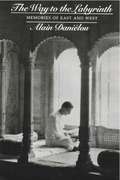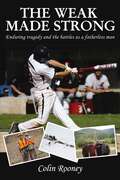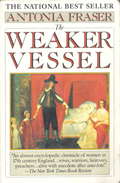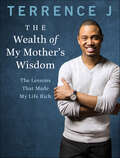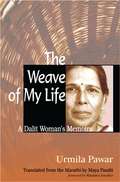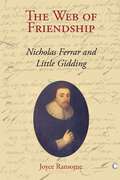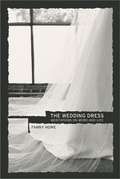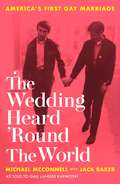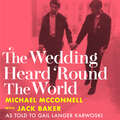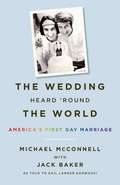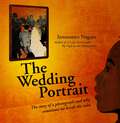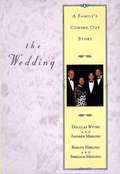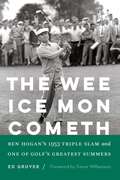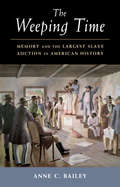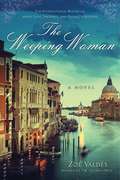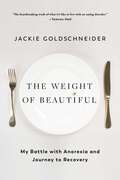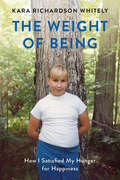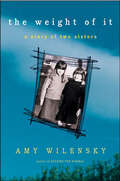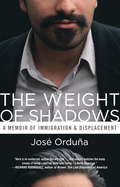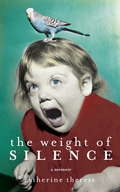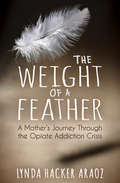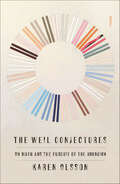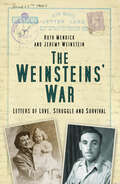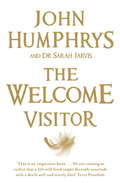- Table View
- List View
The Way to the Labyrinth: Memories Of East And West
by Alain Daniélou"Alain Daniélou is well-known to scholars in Oriental religion and linguistics. He is bound to become world famous as the author of a great autobiography, whose scenes and figures are of both the East and the West and whose psychology is conspicuously of our time. We are fortunate to have it in a faithful and eloquent translation" —Jacques Barzun An authority on Hinduism and renowned for his directorship of the Institute of Comparative Music Studies in Berlin and Venice, Alain Daniélou is also an accomplished pianist, dancer, player of the Indian vînâ, painter, linguist and translator, photographer, and world traveler. To these attainments he has added The Way to the Labyrinth––as vivid, uninhibited, and wide-ranging a memoir as one is ever likely to encounter, now translated and published in English for the first time. Born of a haute-bourgeoise French family––his mother an ardent Catholic, his father an anticlerical leftwing politician, his older brother a cardinal––Daniélou spent a solitary childhood. Escaping from his family milieu, he went to Paris, where he fell in with avant-garde, bohemian, sexually liberated circles, among whose luminaries were Cocteau, Diaghilev, Max Jacob, and Maurice Sachs. But however fervently he plunged into various activities, he felt some other destiny awaited him. After a number of journeys, some of them highly adventurous, he found his real home in India. He spent twenty years there, fifteen of them in Benares on the banks of the Ganges. There he immersed himself in the study of Sanskrit, Hindu philosophy, music, and the art of the ancient temples of Northern India, and converted to the Hindu religion. But times changed, and soon after India gained its independence, he returned to live again in Europe and devoted much of his great energy to the encouragement of traditional musics from around the world.
The Weak Made Strong: Enduring tragedy and the battles as a fatherless man
by Colin RooneyAfter enduring tragedy through losing his dad and older brother in a plane crash, Colin’s perfect life was crushed. Through his faith in Jesus he had hope to keep pressing on through the pain. During his junior season of baseball at Pepperdine University, God did some amazing things on the baseball field. From hitting a game-winning walk off homerun while his nephew throughout the first pitch to receiving a Gold Glove Award using his older brother’s glove, these things weren’t coincidences, they were miracles. After Colin’s baseball career he endured many challenges not having his dad around to lead him and help teach him how to be a man. These things he faced were emotional lions that came against him trying to defeat him and keep him from being the man that God created him to be. Through his realness and honesty about his wound and the depression, anxiety, and fear that he has experienced as a fatherless man, Colin hopes to encourage others who are facing similar struggles so that they will see that God wants to use their weaknesses and challenges that they are facing to do great things for His glory.
The Weaker Vessel: Women's Lot in Seventeenth-Century England
by Antonia FraserThe renowned historian and biographer Lady Antonia Fraser, author of Marie Antoinette, investigates the lot of women in seventeenth-century England. Drawing on period diaries, letters, and other papers, Fraser sketches portraits of a variety of women, both highborn and humble, during the tumultuous century between the death of Elizabeth and Queen Anne's assumption of the throne. More than a collection of female biographies, The Weaker Vessel offers fresh insight into its subjects' attitudes and lives, with appearances by heiresses and dairy maids, holy women and prostitutes, criminals and educators, widows and witches, midwives and mothers, heroines, courtesans, prophetesses, businesswomen, ladies of the court, and that new breed, the actress."An almost encyclopedic chronicle of women in 17th century England...wives, warriors, heiresses, preachers... alive with anecdote after anecdote." - The New York Times Book Review
The Wealth of My Mother's Wisdom: The Lessons That Made My Life Rich
by Terrence J.In this uplifting memoir, “the amiable on-screen personality and actor reveals the source of his good fortune: his tender and tenacious mother” (Essence).When Lisa Gonzalez, a seventeen-year-old from Queens, New York, found out she was pregnant, she knew she only had one choice—to keep the child and give him the best life she could. That baby was Terrence Jenkins, better known to the world as Terrence J. From hosting gigs on BET's 106 and Park and E! News to roles in some of Hollywood's biggest movies, Terrence J is living a life he could have only imagined when he was a young boy. But it was the lessons he learned from his mother that helped make him a man—lessons about sacrifice, courage, loyalty, dreams, and perseverance. Through her words and her actions, Lisa showed Terrence the right path.From an early age Terrence's mother pushed him to succeed and led by example. Most important, she put her son first—even if it meant leaving behind the only life she had ever known in New York City in search of a safer environment for her son, having the drive to go back to school to learn a new skill, or having the courage to start her own business and build it from the ground up. Her drive eventually became Terrence's drive.Inspirational, funny, and down-to-earth, The Wealth of My Mother's Wisdom offers stories, lessons, and advice from one of the top young names in Hollywood, along with input from some of his famous friends like Kevin Hart, Ludacris, T.I., Trey Songz, and Laz Alonso. Terrence J offers a positive, powerful message: with a strong family bond, the possibilities are endless.
The Weave of My Life: A Dalit Woman's Memoirs
by Urmila Pawar"My mother used to weave aaydans, the Marathi generic term for all things made from bamboo. I find that her act of weaving and my act of writing are organically linked. The weave is similar. It is the weave of pain, suffering, and agony that links us."Activist and award-winning writer Urmila Pawar recounts three generations of Dalit women who struggled to overcome the burden of their caste. Dalits, or untouchables, make up India's poorest class. Forbidden from performing anything but the most undesirable and unsanitary duties, for years Dalits were believed to be racially inferior and polluted by nature and were therefore forced to live in isolated communities.Pawar grew up on the rugged Konkan coast, near Mumbai, where the Mahar Dalits were housed in the center of the village so the upper castes could summon them at any time. As Pawar writes, "the community grew up with a sense of perpetual insecurity, fearing that they could be attacked from all four sides in times of conflict. That is why there has always been a tendency in our people to shrink within ourselves like a tortoise and proceed at a snail's pace." Pawar eventually left Konkan for Mumbai, where she fought for Dalit rights and became a major figure in the Dalit literary movement. Though she writes in Marathi, she has found fame in all of India. In this frank and intimate memoir, Pawar not only shares her tireless effort to surmount hideous personal tragedy but also conveys the excitement of an awakening consciousness during a time of profound political and social change.
The Web of Friendship: Nicholas Ferrar and Little Gidding
by Joyce RansomeA portrait of Nicholas Ferrar and his family, to whom he dedicated his ministry, with a focus on his background and the education and experiences that shaped that ministry and the circumstances that brought them to Little Gidding. This book appeals for its detailed account of a family's life together as well as the spiritual aspirations that made their household a community. Later generations appealed to their example both for its mission and its method. Not only does Ransome describe the man and the family in a way that brings them alive but also encompasses both their strength and their human frailties and indicates their contemporary and future significance. The book is aimed at both an academic and general audience of readers interested in history, religion, education, and family relationships including the role of women.
The Wedding Dress: Meditations on Word and Life
by Fanny HoweThis selection of poetic essays constitutes an intellectual memoir by an award-winning poet and scholar. Howe meditates on the role of the artist, on her domestic and political life in Boston in the late 60s and 70s, and on the impact of theology and religion, particularly Catholicism, on her work and the work of others.
The Wedding Heard 'Round the World: America's First Gay Marriage
by Gail Langer Karwoski Jack Baker Michael McConnellFifty years after their marriage, Jack and Michael's story is one of the milestone events in the fight for equal rights, and this memoir the unmissable account a remarkable couple.On September 3, 1971, at the dawn of the modern gay movement, Michael McConnell and Jack Baker exchanged vows in the first legal same-sex wedding in the United States. But the battle to get there - legal and emotional - was only the start of their incredible lives together.Jack enrolled in law school, keeping his promise to Michael that he would figure out a way to marry. He did, but the repercussions would echo not only through their lives, but through those of everyo gay person in the US who ever wanted what this one pioneering couple did: a happy family life. This is the story of how they met, how they married, and what came after. And one wedding heard 'round the world.'A beautiful, well-written love story that is heartrending and ultimately heartwarming'Robert Alexander, New York Times bestselling author of The Kitchen Boy'A fascinating story of love and struggle that reads like a novel'Washington Book Review
The Wedding Heard 'Round the World: America's First Gay Marriage
by Gail Langer Karwoski Jack Baker Michael McConnellFifty years after their marriage, Jack and Michael's story is one of the milestone events in the fight for equal rights, and this memoir the unmissable account a remarkable couple.On September 3, 1971, at the dawn of the modern gay movement, Michael McConnell and Jack Baker exchanged vows in the first legal same-sex wedding in the United States. But the battle to get there - legal and emotional - was only the start of their incredible lives together.Jack enrolled in law school, keeping his promise to Michael that he would figure out a way to marry. He did, but the repercussions would echo not only through their lives, but through those of everyo gay person in the US who ever wanted what this one pioneering couple did: a happy family life. This is the story of how they met, how they married, and what came after. And one wedding heard 'round the world.'A beautiful, well-written love story that is heartrending and ultimately heartwarming'Robert Alexander, New York Times bestselling author of The Kitchen Boy'A fascinating story of love and struggle that reads like a novel'Washington Book Review
The Wedding Heard 'Round the World: America's First Gay Marriage
by Jack Baker Michael McConnellOn September 3, 1971, Michael McConnell and Jack Baker exchanged vows in the first legal same-sex wedding in the United States. Their remarkable story is told here for the first time—a unique account of the passion and energy of the gay liberation movement in the sixties and seventies. At the dawn of the modern gay movement (while New York&’s Stonewall riots and San Francisco&’s emerging political activism bloomed), these two young men insisted on making their commitment a legal reality. They were already crusaders for gay rights: Jack had twice been elected the University of Minnesota&’s student president—the first openly gay university student president in the country, an election reported by Walter Cronkite on network TV news. They were featured in Look magazine&’s special issue about the American family and received letters of support from around the world. The couple navigated complex procedures to obtain a state-issued marriage license. Their ceremony was conducted by a Methodist minister in a friend&’s tiny Minneapolis apartment. Wearing matching white pantsuits, exchanging custom-designed rings, and sharing a tiered wedding cake, Michael and Jack celebrated their historic marriage. After reciting their vows, they sealed their promise to love and honor each other with a kiss and a signed marriage certificate. Repercussions were immediate: Michael&’s job offer at the University of Minnesota was rescinded, leading him to wage a battle against job discrimination with the help of the Minnesota Civil Liberties Union. The couple eventually reached the U.S. Supreme Court with two precedent-setting cases. Michael and Jack have retired from the public spotlight, but after four decades their marriage is still their joy and comfort. Living quietly in a Minneapolis bungalow, they exemplify a contemporary version of the American dream. Only now, with marriage equality in the headlines and the Supreme Court decision to make love the law of the land, are they willing to tell the entire story of their groundbreaking experiences. TIME magazine listed the twenty-five most influential marriages of all time and included Michael and Jack, and they were recently profiled in a cover story in the Sunday New York Times. Their long campaign for marriage equality and insistence on equal rights for all citizens is a model for advocates of social justice and an inspiration for everyone who struggles for acceptance in a less-than-equal world.
The Wedding Portrait
by Innosanto NagaraThe Wedding Portrait is an essential book for kids about standing up for what's right. Here are stories of direct action from around the world that are bookended by the author's wedding story. He and his bride led their wedding party to a protest, and were captured in a photo by the local newspaper kissing in front of a line of police just before being arrested. "We usually follow the rules. But sometimes, if you see something is wrong--more wrong than breaking the rules and by breaking the rules you might stop it--you may need to break the rules." When indigenous people in Colombia block an oil company from destroying their environment--this is a blockade; when Florida farmworkers encourage people not to buy their tomatos because the farm owners won't pay them for their hard work--this is called a boycott; and when Claudette Colvin takes a seat in the front of the bus to protest racism--this is called civil disobedience. In brilliantly bright and inspiring illustrations we see ordinary people say No--to unfair treatment, to war, to destroying the environment. Innosanto Nagara has beautifully melded an act of love with crucial ideas of civil disobedience and direct action that will speak to young readers' sense of right and wrong. There has never been a more important moment for Innosanto Nagara's gentle message of firm resolve.
The Wedding: A Family's Coming Out Story
by Douglas Wythe Andrew Merling Roslyn Merling Sheldon Merling<p>Two people meet and fall in love. Over time, their relationship grows and they decide to spend the rest of their lives together. They plan a wedding, a formal binding into a permanent relationship with family and friends on hand as witnesses to solemn but beautiful vows. It's an occasion people dream about for most of their lives, though it is often joked that the wedding is more for the parents than the children. <p>But what if they''re gay? Andrew Merling was a graduate student in clinical psychology when he met Doug Wythe, a television promotion director. Their relationship continued for three-and-a-half years before Doug formally proposed marriage to Andrew. Together, they agreed to have a traditional affair for family and friends. While Doug was not as close to his extended family, Andrew came from large, tight-knit Jewish family in Montreal. When he announced his engagement and the couple's plans for a traditional Jewish ceremony and a festive celebration, it was then that previously unacknowledged prejudices and hidden concerns suddenly reared their contentious heads. Typical wedding conflicts over money and manners paled next to worries over whether Andrew''s parents would find themselves ostracized by their conservative community. <p>Then, just two months before the big day, the family had to decide if they were ready to perform the ultimate act of "coming out," when ABC-TV News asked to profile them as part of an episode on Turning Point, and bring national attention to their personal struggle. The first book to speak to both sides of a controversy that is altering our society, this fascinating chronicle follows Doug, Andrew, and his parents Sheldon and Roslyn on the rocky road from engagement to understanding. With the impending wedding as a catalyst, they embark on a painful, joyful odyssey of discovery, struggling both to be heard and to find acceptance from each other, their friends and communities. Their four distinct voices blend to create a unique depiction of one family coming to grips with the reality of being a gay couple in today's world.</p>
The Wee Ice Mon Cometh: Ben Hogan's 1953 Triple Slam and One of Golf's Greatest Summers
by Ed GruverIt is considered by many the greatest season in golf history. In 1953 Ben Hogan provided a fitting exclamation point to his miraculous comeback from a near-fatal auto accident by becoming the first player to win golf&’s Triple Crown—the Masters, the U.S. Open, and the British Open—within a span of four months. It was closer than anyone had gotten to the modern-day Grand Slam of winning all four of golf&’s major tournaments.The Wee Ice Mon Cometh is the first book to detail Hogan&’s historic accomplishment. His 1953 season remains the world&’s greatest, and golfers seek to match his achievement every year. Bobby Jones in 1930 and Tiger Woods in 2000–2001 achieved comparable &“slams,&” but the Hogan Slam stands alone due to the car crash four years before that left Hogan on shattered legs. He nonetheless won with record-setting performances on three of the most challenging courses in the world: Augusta National at the Masters, the U.S. Open at Oakmont, and the British Open at Carnoustie, Scotland. Ed Gruver weaves together interviews with members of Hogan&’s family, golf historians, playing partners, and business partners along with extensive research and eyewitness accounts of each tournament. Seventy years after his historic feat, the Hogan Slam still serves as a symbol for the many comebacks Hogan had to make throughout his life—his father&’s death by suicide when Ben was a boy, desperate days during the Great Depression, frustrating failures in tournaments early in his career, and the horrific accident that nearly killed him just as he was finally reaching the pinnacle of his profession.
The Weeping Time: Memory and the Largest Slave Auction in American History
by Anne C. BaileySynopsis coming soon. . . . . . .
The Weeping Woman: A Novel
by Zoé Valdés David Frye<P> A writer resembling Zoé Valdés--a Cuban exile living in Paris with her husband and young daughter--is preparing a novel on the life of Dora Maar, one of the most promising artists in the Surrealist movement until she met Pablo Picasso. The middle-aged Picasso was already the god of the art world's avant-garde. Dora became his lover, muse, and ultimately, his victim. She became The Weeping Woman captured in his famous portrait, the mistress he betrayed with other mistress-muses, and their affair ended with her commitment to an asylum at the hands of Picasso's friends. <P> The writer's research centers on a mysterious trip to Venice that Dora took fifteen years later, in the company of two young gay men who were admirers of Picasso, including the biographer James Lord. After this episode, Dora cut off contact with the world and secluded herself in her Paris apartment until her death. "After Picasso, God," she would say. What happened in Venice? The more the writer investigates, the more she finds herself implicated in a story of passion taken to the extremes. In The Weeping Woman, prize-winning novelist Zoé Valdés narrates the journey of a woman who would do anything and everything for love. <P> <b> Winner of the prestigious Azorín Prize for Fiction </b>.
The Weight of Beautiful
by Jackie GoldschneiderJackie Goldschneider, star of The Real Housewives of New Jersey, bravely chronicles her decades-long battle with anorexia and public journey to recovery in this unflinching, moving, and ultimately inspiring self-written memoir.All Jackie Goldschneider ever wanted was to be thin. As a child, she&’d stand in front of the mirror, sucking in her stomach and arching her back to feel her ribs, praying to see a model-like figure looking back. As an obese teen, lonely and tormented by her weight, her doctor encouraged her to start dieting, ultimately leading to a prolonged battle with anorexia that nearly took her life. After decades of hiding her eating disorder from friends, family, and the world, Jackie is ready to expose the realities of her devastating struggle with anorexia, including the harrowing day-to-day tactics she employed to count calories and restrict meals, her struggles with fertility and pregnancy, the effects her eating disorder had on her relationships with her husband and children, and ultimately how, in a twist of fate, becoming a reality TV star saved her life. The Weight of Beautiful is Jackie&’s personal story, but within it are also the stories of millions like her, striving to lead healthy, happy lives despite their eating disorders. In the vein of Unbearable Lightness, Hiding from Reality, and What Remains, The Weight of Beautiful is a moving testament of strength, honesty, and recovery.
The Weight of Being: How I Satisfied My Hunger for Happiness
by Kara Richardson WhitelyA brutally honest story about being fat in America--and one woman's experience with radical weight loss after a lifetime of fat shamingKara Richardson Whitely thought she could do anything. After all, she climbed Mount Kilimanjaro-three times! But now she's off the mountain and back home again, and there's one thing she just can't manage to do: lose weight. In many ways, Kara is living the life of everywoman, except that she's not everywoman because she weighs 300 pounds and is tormented by binge eating disorder. Her weight is a constant source of conflict and shame, as the people from every corner of her life, from her coworkers to the neighbors down the street, judge Kara for the size of her body. When it becomes just too much to tolerate, Kara turns to therapy and weight-loss surgery, a choice that transforms her body-and her life.Kara's story is one of living as a fat woman in America, where fat prejudice is rampant despite our nation's pandemic of obesity. In this fresh, raw memoir, Kara reveals this epic contradiction, and offers a revealing comparison of life before and after radical weight loss.
The Weight of It: A Story of Two Sisters
by Amy WilenskyA deeply affecting memoir about the bond between two sisters—and the 150 pounds that nearly separated themAs young girls, a year apart in age, Alison and Amy Wilensky were almost indistinguishable. And they were inseparable: growing up in a comfortable Boston suburb, they were never far from each other's side, wearing matching dresses, playing the same games, eating the same food. But Alison began gaining weight in elementary school and by the time she was sixteen was morbidly obese. The sisters remained close, but over the years the daily indignities and affronts endured by Alison took their toll, reshaping her identity indelibly and affecting the sisters' relationship in unanticipated ways.In her late twenties, Alison underwent gastric bypass surgery, in the wake of which she lost more than 150 pounds and achieved the shape she'd dreamed of for so much of her life. It wasn't just her body that was transformed: every significant relationship in her life was profoundly altered. The Weight of It is a universal story of how we discover what makes us who we are, and how we become the people we want to be. Amy Wilensky is uniquely equipped to write this book, and she does so with fine perception, insight, and compassion.
The Weight of Shadows: A Memoir of Immigration & Displacement
by José OrduñaTracing his story of becoming a US citizen, José Orduña's memoir explores the complex issues of immigration and assimilation.José Orduña chronicles the process of becoming a North American citizen in a post-9/11 United States. <P> <P> Intractable realities--rooted in the continuity of US imperialism to globalism--form the landscape of Orduña's daily experience, where the geopolitical meets the quotidian. In one anecdote, he recalls how the only apartment his parents could rent was one that didn't require signing a lease or running a credit check, where the floors were so crooked he once dropped an orange and watched it roll in six directions before settling in a corner. Orduña describes the absurd feeling of being handed a piece of paper--his naturalization certificate--that guarantees something he has always known: he has every right to be here. A trenchant exploration of race, class, and identity, The Weight of Shadows is a searing meditation on the nature of political, linguistic, and cultural borders, and the meaning of "America."From the Trade Paperback edition.
The Weight of Silence: A memoir
by Catherine ThereseA moving and funny childhood memoir ... timeless.' AUSTRALIAN WOMEN'S WEEKLY 'This is a special memoir. It is written with great feeling, imagination, humour and originality, and shows a writer with a distinct view of the world within and around her.' AUSTRALIAN BOOKSELLER & PUBLISHER MAGAZINEDo you remember the day you realised you were you?Catherine Therese does and invites you inside her head and upside down on a unique coming-of-age rollercoaster, chased by a purple feather duster through the sticky bitumen suburban streets of her 70s childhood - egged by Bernard King, terrorised by a frizzy-haired hooker with an axe - to going all the way with Meatloaf and a boy with half a thumb, in her achingly funny, intensely moving memoir ...The story of a girl losing and finding herself in the secrets that shape her life; the power of family, silence, language, grog and love ... of becoming who you truly are. A mother before she's a woman; a girl who carries a shard of windscreen glass, votes for herself and believes in holding rain.THE WEIGHT OF SILENCE is a brave beautiful book that will break your heart and mend it in the same breath.
The Weight of a Feather: A Mother's Journey Through the Opiates Addiction Crisis
by Lynda Hacker AraozA mother recounts her journey with her son through his trials of addiction and his long road to recovery in a memoir full of honesty, humor, and hope. The Weight of a Feather chronicles the relationship between a mother and her son from his journey into the dark world of addiction to his final recovery years later. In this raw and candid memoir, Lynda Hacker Araoz is ruthlessly honest about the deception, betrayal, and violence inherent in the world of addiction, as well as the many pitfalls one encounters on the pathway to recovery. However, she balances out the weight of her family&’s struggles with lighter moments of connection with her son and the absurdities they encounter. Above all, The Weight of a Feather is a testimony to the enduring strength of family love. It brings comfort and hope to others who are going through a similar ordeal and provides insight for those who wonder why recovery can be so elusive. Lynda urges readers to take a fresh look at the world of addiction, calling for a new model for treatment in light of the opioid epidemic impacting families across the country.
The Weil Conjectures: On Math and the Pursuit of the Unknown
by Karen OlssonA New York Times Editors' Pick and Paris Review Staff Pick"A wonderful book." --Patti Smith"I was riveted. Olsson is evocative on curiosity as an appetite of the mind, on the pleasure of glutting oneself on knowledge." --Parul Sehgal, The New York TimesAn eloquent blend of memoir and biography exploring the Weil siblings, math, and creative inspirationKaren Olsson’s stirring and unusual third book, The Weil Conjectures, tells the story of the brilliant Weil siblings—Simone, a philosopher, mystic, and social activist, and André, an influential mathematician—while also recalling the years Olsson spent studying math. As she delves into the lives of these two singular French thinkers, she grapples with their intellectual obsessions and rekindles one of her own. For Olsson, as a math major in college and a writer now, it’s the odd detours that lead to discovery, to moments of insight. Thus The Weil Conjectures—an elegant blend of biography and memoir and a meditation on the creative life.Personal, revealing, and approachable, The Weil Conjectures eloquently explores math as it relates to intellectual history, and shows how sometimes the most inexplicable pursuits turn out to be the most rewarding.
The Weinsteins' War: Letters of Love, Struggle and Survival
by Jeremy Weinstein Ruth MendickFrom its onset, the Second World War changed the course of many couples’ lives as they were parted, not knowing if they would ever see their partners again. Documenting the hopes and the heartbreak of the young Jewish Weinstein family, this book uses a treasure trove of 700 letters sent between husband and wife to depict the everyday struggles of lovers surviving apart as war wore on in Europe and North Africa.The letters, always vivid, sometimes funny, often passionate, contain intimate details of the pressure on the young couple, dealing with conditions at home and abroad, family and political rivalries, and even tension as talk of the temptation and ease of ‘playing away’ arises. The Weinsteins’ War is an honest portrayal of the strains of sustaining a loving relationship when so far apart and of the hopes the couple had for a new, post-war Britain.
The Welcome Visitor
by John Humphrys'This is an important book. It needs to be ... we are coming to realise that a life well lived might decently conclude with a death well and timely died' TERRY PRATCHETT'Impassioned and impressive' SUNDAY TIMES'A powerful, compassionate book' FT ON SUNDAY* * * * * * *From presenter of Radio 4's Today & national treasure John Humphrys, one of the first books to deal unflinchingly with death and dying well, written in conjunction with a high-profile GP.Death is a subject modern society shies away from. Even doctors avoid the word. But if we regard death as a failure in our desire to prolong life, can we ever arrive at a humane approach to those whose lives have lost meaning? Are we keeping people alive simply because we can?Inspired by his own experience with his father's death from Alzheimer's, John Humphrys and co-author Dr Sarah Jarvis take a wider look at how our attitudes to death have changed as doctors have learned how to prolong life beyond anything that could have been imagined only a few generations ago, and confront one of the great challenges facing the western world today. There are no easy answers but the first step must surely be to accept that death can be as welcome as it is inevitable.The Welcome Visitor is a book which brings genuine knowledge and insight to a taboo subject, while asking the difficult questions that need to be asked about our attitudes and approach to the realities of end-of-life care.
The Welcome Visitor: Living Well, Dying Well
by John Humphrys'This is an important book. It needs to be ... we are coming to realise that a life well lived might decently conclude with a death well and timely died' TERRY PRATCHETT'Impassioned and impressive' SUNDAY TIMES'A powerful, compassionate book' FT ON SUNDAY* * * * * * *From presenter of Radio 4's Today & national treasure John Humphrys, one of the first books to deal unflinchingly with death and dying well, written in conjunction with a high-profile GP.Death is a subject modern society shies away from. Even doctors avoid the word. But if we regard death as a failure in our desire to prolong life, can we ever arrive at a humane approach to those whose lives have lost meaning? Are we keeping people alive simply because we can?Inspired by his own experience with his father's death from Alzheimer's, John Humphrys and co-author Dr Sarah Jarvis take a wider look at how our attitudes to death have changed as doctors have learned how to prolong life beyond anything that could have been imagined only a few generations ago, and confront one of the great challenges facing the western world today. There are no easy answers but the first step must surely be to accept that death can be as welcome as it is inevitable.The Welcome Visitor is a book which brings genuine knowledge and insight to a taboo subject, while asking the difficult questions that need to be asked about our attitudes and approach to the realities of end-of-life care.
